Hazard Mitigation of a Landslide-Prone Area through Monitoring, Modeling, and Susceptibility Mapping
Abstract
:1. Introduction
2. Background of Study Area
2.1. Topography
2.2. Temperature and Rainfall
2.3. Geology
2.4. Google Earth Images Taken between 2006 and 2018
3. Methods of Study
3.1. Ground Investigations
3.1.1. Boreholes Exploration
3.1.2. Electrical Resistivity Tomography (ERT)
3.2. Field Monitoring
Observation Wells
3.3. Inclinometers
3.4. Seepage and Stability Analyses
4. Results and Discussion
4.1. Ground Investigation Results
4.1.1. Slopes Materials
4.1.2. Groundwater Level of Study Slopes
4.1.3. Lateral Displacement of Slopes
4.2. Factors Causing Short-Term Sliding
4.3. Factors Causing Long-Term Sliding
- High susceptibility (red): Evidence of sliding, such as sliding surfaces, indicated by monitoring instruments, new cracks, ground subsidence, or broken drainage ditches within the sliding body, was found during field checking.
- Moderate susceptibility (blue): No evidence of sliding was found; however, signs of impending sliding, such as scarp, tilted ground, old cracks, and colluvium deposits, were observed during field checking.
- Low susceptibility (green): No obvious signs of soil slippage were seen during the field checking but could be inferred from topography features.
4.4. Hazard Mitigation
5. Conclusions
- It was astonishing to learn that the river-bed of the river at the toe of the studied large-scale slope has been raised by more than 30 m within a period of five years as a result of the inundation of debris from upstream after the construction of a dam downstream of the study site.
- The infiltration of rainwater from the surface of the slope, the upraised river-bed elevation, and the erosion of the river bank of the toe of the slopes have altered the landform and the groundwater level of the large-scale slope and eventually triggered several localized slope failures. The results of the uncoupled hydromechanical slope stability analysis where the analyzed slopes were subjected to a designed storm for a 50-year return period in 24 h revealed that a sliding surface was triggered within the depth of the colluvium. The thickness of the simulated sliding surface coincided with that observed on site.
- The landform of the Taibaojiu Ecktreppe at the crest of the study area has somehow crept into a double-crested ridge or ridge-top depression, indicating that the study area is being subjected to large-scale deep-seated gravitational slope deformation (DSGSD) by means of mass rock creep. Although the creeping rate has yet to be quantified, the study’s large-scale slope is believed to be creeping gradually. The orientation of the on-site foliations has also revealed the inherent danger of the northern and southern slopes in which huge and catastrophic landslides could eventually be triggered. Based on field monitoring records and the orientation of the foliations, the associated DSGSD surface was deduced to be developed along the interface of the disturbed (SL1) and undisturbed (SL2) slates.
- An intriguing pattern of resistivity distribution was observed from the results of the Wenner–Schlumberger and pole–pole arrays. Unlike low resistivity-based colluvium that occasionally mingled with some high resistivity readings, areas with a concentrated high resistivity reading were found to be associated with the orientation of the foliated rock mass. Further studies could be conducted to verify the reason for this association.
Author Contributions
Funding
Institutional Review Board Statement
Informed Consent Statement
Data Availability Statement
Acknowledgments
Conflicts of Interest
Abbreviations
| 921-Jiji | 21 September 1999 Jiji Earthquake |
| Cv | Colluvium |
| ERT | Electrical Resistivity Tomography |
| FOS | Factor of Safety |
| SL1 | Disturbed Slate Formation |
| SL2 | Undisturbed Slate Formation |
References
- Shou, K.J.; Wu, C.C.; Lin, J.F. Predictive analysis of landslide susceptibility under climate change conditions—A study on the Ai-Liao watershed in southern Taiwan. J. Geoeng. 2019, 13, 013–027. [Google Scholar]
- Weng, M.C.; Lin, M.L.; Lo, C.M.; Lin, H.H.; Lin, C.H.; Lu, J.H.; Tsai, S.J. Evaluating failure mechanisms of dip slope using a multiscale investigation and discrete element modelling. Eng. Geol. 2019, 263, 105303. [Google Scholar] [CrossRef]
- Tsao, M.C.; Lo, W.; Chen, W.L.; Wang, T.T. Landslide-related maintenance issues around mountain road in Dasha River section of Central Cross Island Highway, Taiwan. Eng. Geol. 2021, 80, 813–834. [Google Scholar] [CrossRef]
- Tseng, C.H.; Chan, Y.C.; Jeng, C.J.; Rau, R.J.; Hsieh, Y.C. Deformation of landslide revealed by long-term surficial monitoring: A case study of slow movement of a dip slope in northern Taiwan. Bull. Eng. Geol. Environ. 2021, 284, 106020. [Google Scholar] [CrossRef]
- Lo, P.C.; Lo, W.; Chiu, Y.C.; Wang, T.T. Movement characteristics of a creeping slope influenced by river erosion and aggradation: Study of Xinwulü River in southeastern Taiwan. Eng. Geol. 2021, 295, 106443. [Google Scholar] [CrossRef]
- The World Bank. Understanding Poverty: Indigenous People. Available online: https://www.worldbank.org/en/topic/indigenouspeoples (accessed on 20 June 2022).
- Lee, C.C.; Ding, C.; Chen, B.A.; Chen, H.H. Large-scale landslide investigation and governance planning: A case study on Tabuk Village (D306), Heping District of Taichung City. J. Prof. Eng. 2020, 91, 39–48. (In Mandarin) [Google Scholar]
- Lee, C.C.; Tsai, L.L.Y.; Yang, C.H.; Wen, K.L.; Wang, Z.B.; Hsieh, Z.H.; Liu, H.C. The identified origin of a linear slope near Chi–Chi earthquake rupture combining 2D, 3D resistivity image profiling and geological data. Environ. Geol. 2008, 58, 1397. [Google Scholar] [CrossRef]
- Ho, S.K. D036 Large-Scale Landslide Investigation and Governance Planning for Heping District of Taichung City; Report No. SWCB-106-204; Soil and Water Conservation Bureau, Council of Agriculture: Taichung, Taiwan, 2017; 419p. (In Mandarin)
- Su, M.B.; Chen, I.H.; Liwo, C.H. Using TDR cables and GPS for landslide monitoring in high mountain area. J. Geotech. Eng. ASCE 2009, 135, 1113–1121. [Google Scholar] [CrossRef] [Green Version]
- Weng, M.C.; Chang, C.Y.; Jeng, F.S.; Li, H.H. Topography of Taiwan. Evaluating the stability of anti-dip slate slope using an innovative failure criterion for foliation. Eng. Geol. 2020, 275, 105737. [Google Scholar] [CrossRef]
- Lin, L.L.; Huang, C.C.; Yen, C.Y.; Huang, J.K.; Cheng, Y.S.; Chang, Y.T. Deep seated creep deformation of a slate rock slope—A case study of landslide in Lishan area. Soil Water Conserv. 2010, 42, 1–14. (In Mandarin) [Google Scholar]
- Lin, C.D. Topography of Taiwan. Gen. Chronicles Taiwan Prov. (Land Chronicles Geogr.) 1957, 1, 424. (In Mandarin) [Google Scholar]
- Google Earth Pro 7.3.4.8642. Lishan, Taiwan: N24°16′48″, E121°15′36″. Available online: http://www.google.com/earth/index.html (accessed on 12 May 2022).
- Dai, F.C.; Lee, C.F. Landslides on Natural Terrain: Physical Characteristics and Susceptibility Mapping in Hong Kong. Mt. Res. Dev. 2002, 22, 40–47. [Google Scholar] [CrossRef] [Green Version]
- Pyramid Environmental & Engineering, P.C. Electrical Resistivity. Available online: https://pyramidenvironmental.com/multi-electrode-electrical-resistivity-mer-electrical-resistive-tomography-ert/ (accessed on 2 February 2022).
- Wikipedia Contributors. Electrical Resistivity Tomography. Wikipedia, The Free Encyclopedia. Available online: https://en.wikipedia.org/wiki/Electrical_resistivity_tomography (accessed on 2 February 2022).
- Tamssar, A.H. An Evaluation of the Suitability of Different Electrode Arrays for Geohydrological Studies in Karoo Rocks Using Electrical Resistivity Tomography. Master’s Dissertation, Institute for Groundwater Studies, University of the Free State, Bloemfontein, South Africa, 2013; 183p. [Google Scholar]
- Loke, M.H. Electrical Imaging Surveys for Environmental and Engineering Studies: A Practical Guide to 2-D and 3-D Surveys. 2015. 67p. Available online: https://www.academia.edu/11991713/Electrical_imaging_surveys_for_environmental_and_engineering_studies_A_practical_guide_to_2_D_and_3_D_surveys (accessed on 24 February 2022).
- Hermawan, O.R.; Putra, D.P.E. The effectiveness of Wenner-Schlumberger and dipole-dipole array of 2D geoelectrical survey to detect the occurring of groundwater in the Gunung Kidul Karst aquifer system, Yogyakarta, Indonesia. J. Appl. Geol. 2016, 1, 71–81. [Google Scholar] [CrossRef] [Green Version]
- Advanced Geosciences Inc (AGI). A Comparison of 11 Classical Electrode Arrays. Available online: https://www.agiusa.com/blog/comparison-11-classical-electrode-arrays (accessed on 12 February 2022).
- Zhang, X.; Zhu, C.; He, M.; Dong, M.; Zhang, G.; Zhang, F. Failure mechanism and long short-term memory neural network model for landslide risk prediction. Remote Sens. 2022, 14, 166. [Google Scholar] [CrossRef]
- Van Genuchten, M.T. A Closed-Form Equation of Predicting the Hydraulic Conductivity of Unsaturated Soils. Soil Sci. Soc. Am. J. 1980, 44, 892–898. [Google Scholar] [CrossRef] [Green Version]
- Khoei, A.R.; Mohammadnejad, T. Numerical modeling of multiphase fluid flow in deforming porous media: A comparison between two- and three-phase models for seismic analysis of earth and rockfill dams. Comput. Geotech. 2011, 38, 142–166. [Google Scholar] [CrossRef]
- Airey, D.W.; Ghorbani, J. Analysis of unsaturated soil columns with application to bulk cargo liquefaction in ships. Comput. Geotech. 2021, 140, 104402. [Google Scholar] [CrossRef]
- Khalili, N.; Habte, M.A.; Zargarbashi, S. A fully coupled flow deformation model for cyclic analysis of unsaturated soils including hydraulic and mechanical hystereses. Comput. Geotech. 2008, 35, 872–889. [Google Scholar] [CrossRef]
- Gallipoli, D.; Wheeler, S.J.; Karstunen, M. Modelling the variation of degree of saturation in a deformable unsaturated soil. Géotechnique 2003, 53, 105–112. [Google Scholar] [CrossRef]
- Ghorbani, J.; Airey, D.W.; El-Zein, A. Numerical framework for considering the dependency of SWCCs on volume changes and their hysteretic responses in modelling elasto-plastic response of unsaturated soils. Elsevier Comput. Methods Appl. Mech. Eng. 2018, 336, 80–110. [Google Scholar] [CrossRef]
- Song, X.Y.; Borja, R.I. Mathematical framework for unsaturated flow in the finite deformation range. Int. J. Numer. Methods Eng. 2014, 97, 658–682. [Google Scholar] [CrossRef]
- Al-Karni, A.A.; Al-Shamrani, M.A. Study of the effect of soil anisotropy on slope stability using method of slices. Comput. Geotech. 2000, 26, 83–103. [Google Scholar] [CrossRef]
- Ghorbani, J.; Airey, D.W. Modelling stress-induced anisotropy in multi-phase granular soils. Comput. Mech. 2021, 67, 497–521. [Google Scholar] [CrossRef]
- Chiu, K.H. Characteristics of Cleavage Attitude Distribution in Techi to Lishan Area of Central Taiwan. Master’s Thesis, National Central University, Taoyuan, Taiwan, 2000; 96p. (In Mandarin). [Google Scholar]
- Surface Search Inc. Electrical Resistivity Tomography: What Is It? Available online: https://surfacesearch.com/electrical-resistivity-tomography-what-is-it/ (accessed on 8 August 2022).
- Bossi, G.; Borgatti, L.; Gottardi, G.; Marcato, G. Quantification of the uncertainty in the modelling of unstable slopes displaying marked soil heterogeneity. Landslides 2019, 16, 2409–2420. [Google Scholar] [CrossRef]
- Machan, G.; Bennett, V.G. Use of Inclinometers for Geotechnical Instrumentation on Transportation Projects: State of the Practice; Transportation Research Circular E-C129; Transportation Research Board: Washington, DC, USA, 2008; 92p. [Google Scholar]
- Chigira, M. Long-term gravitational deformation of roicks by mass rock creep. Eng. Geol. 1992, 32, 157–184. [Google Scholar] [CrossRef]
- Delchiaro, M.; Mele, E.; Della Seta, M.; Martino, S.; Mazzanti, P.; Esposito, C. Quantitative investigation of a Mass Rock Creep deforming slope through A-Din SAR and geomorphometry. In Understanding and Reducing Landslide Disaster Risk: Volume 5 Catastrophic Landslides and Frontiers of Landslide Science; Vilímek, V., Wang, F., Strom, A., Sassa, K., Bobrowsky, P.T., Takara, K., Eds.; Springer International Publishing: Cham, Switzerland, 2021; pp. 165–170. [Google Scholar]
- Kasahara, N.; Gonda, Y.; Huvaj, N. Quantitative land-use and landslide assessment: A case study in Rize, Türkiye. Water 2022, 14, 1811. [Google Scholar] [CrossRef]
- Zhong, W.; Zhu, Y.; He, N. Physical Model Study of an intermittent rainfall-induced gently dipping accumulation landslide. Water 2022, 14, 1770. [Google Scholar] [CrossRef]
- Larimit. Surface Drainage Works (Ditches, Channels, Pipeworks). 2023. Available online: https://www.larimit.com/mitigation_measures/957/# (accessed on 24 February 2023).
- Lee, R.W.H.; Law, R.H.C.; Lo, D.O.K. Importance of surface drainage management to slope performance. HKIE Trans. 2018, 25, 182–191. [Google Scholar] [CrossRef]
- Lee, C.C.; Yang, C.H.; Liu, H.C.; Wen, K.L.; Wang, Z.B.; Chen, Y.J. A Study of the hydrogeological environment of the lishan landslide area using resistivity image profiling and borehole data. Eng. Geol. 2008, 98, 115–125. [Google Scholar] [CrossRef]


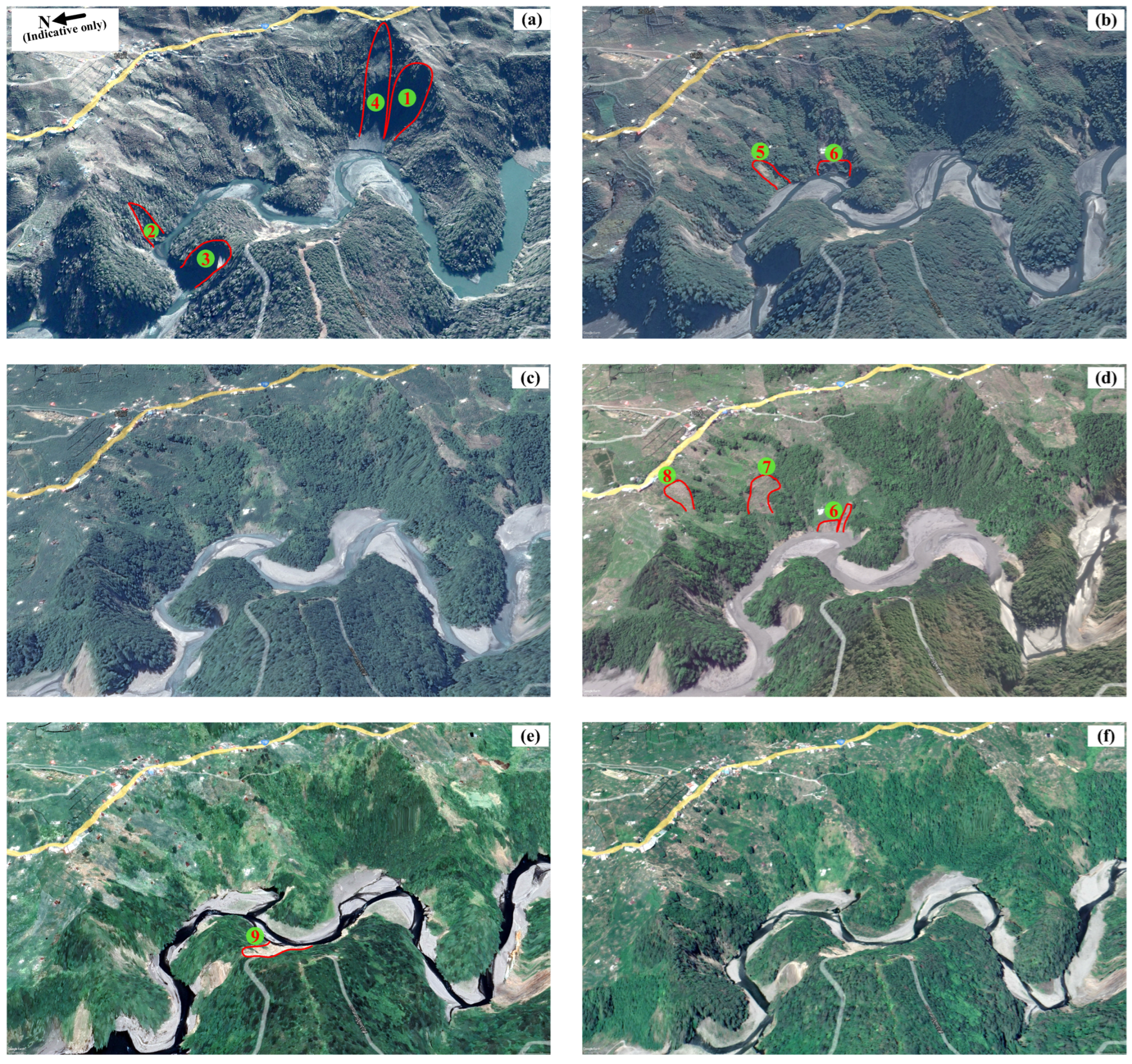

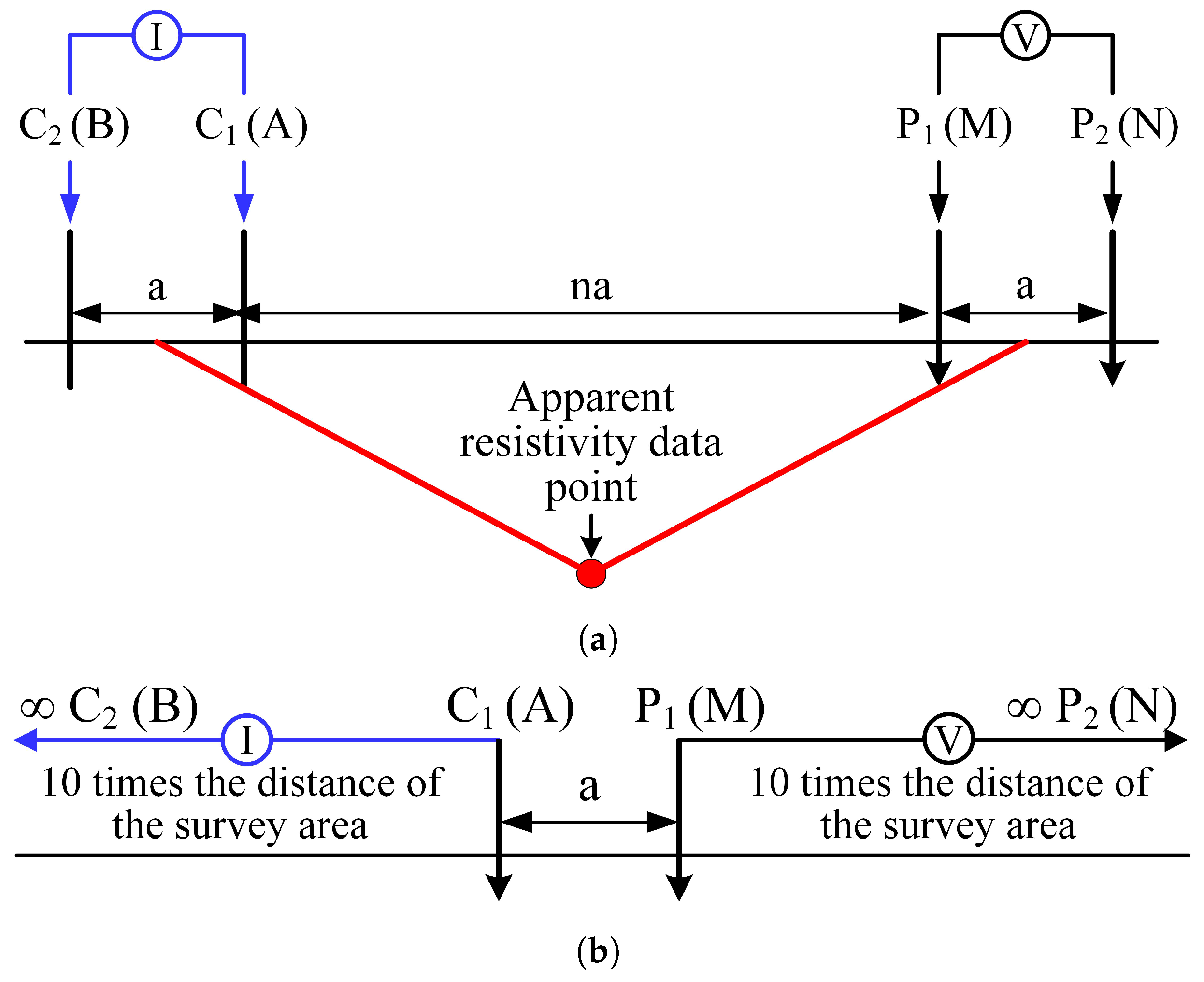
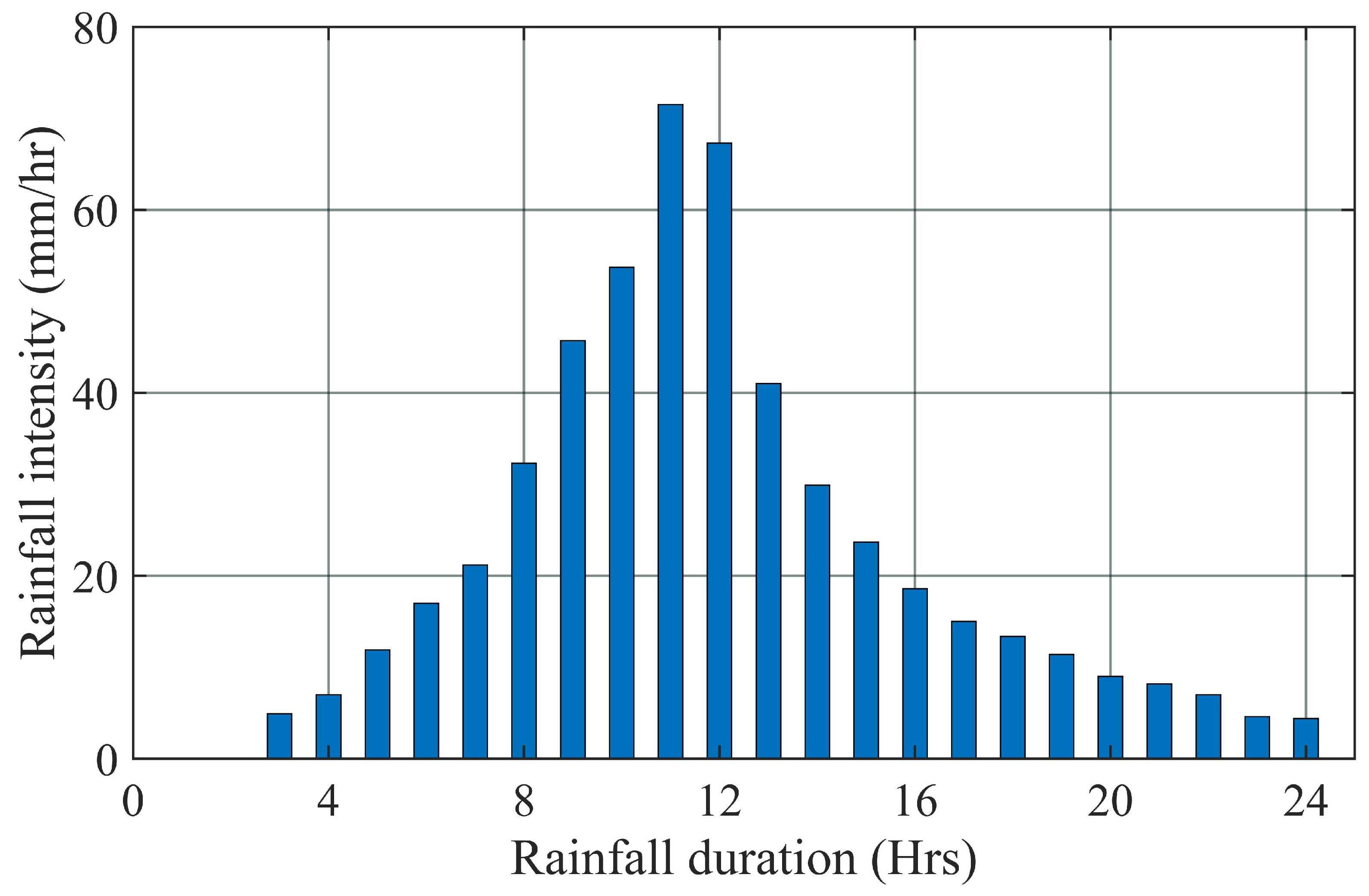


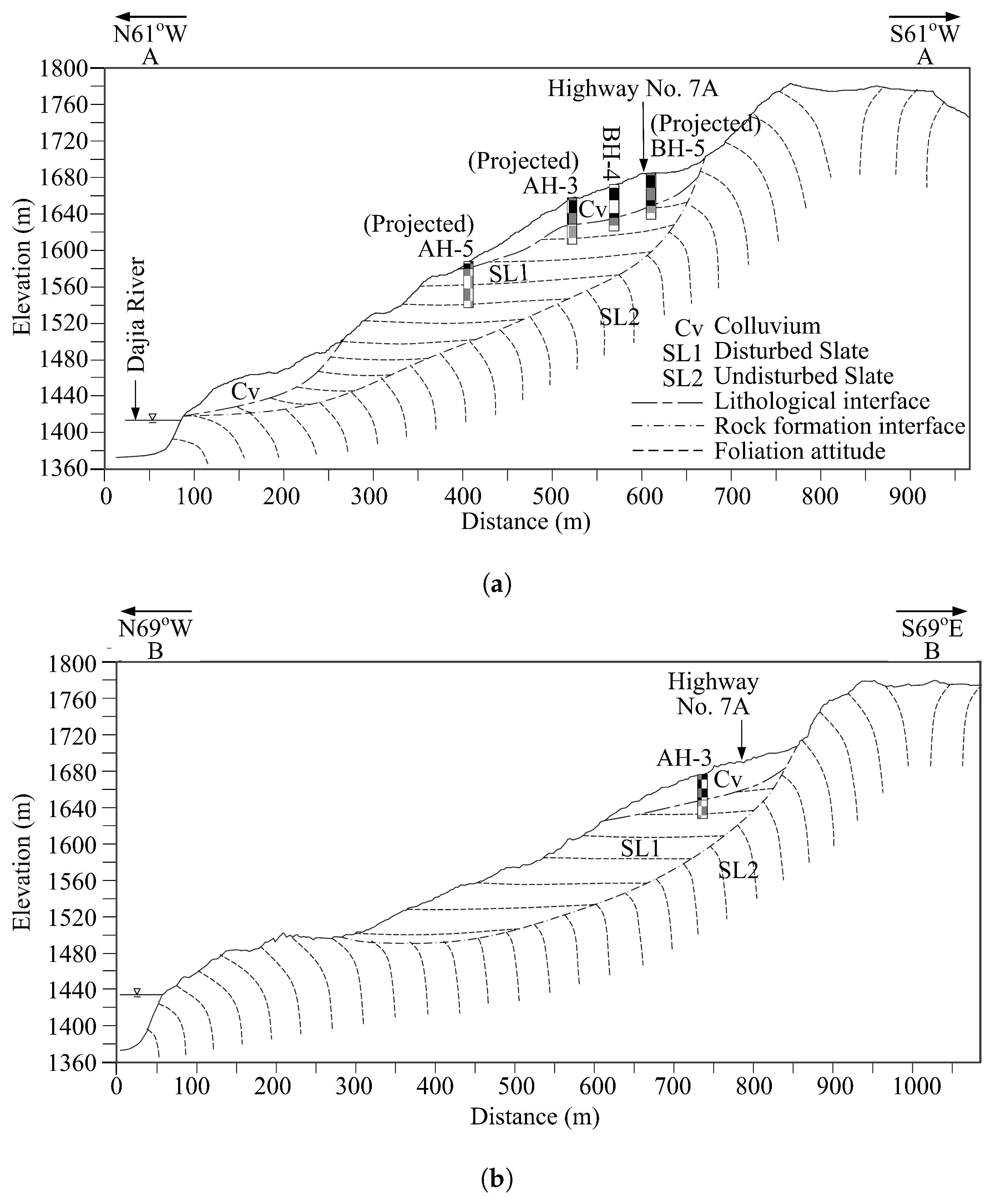
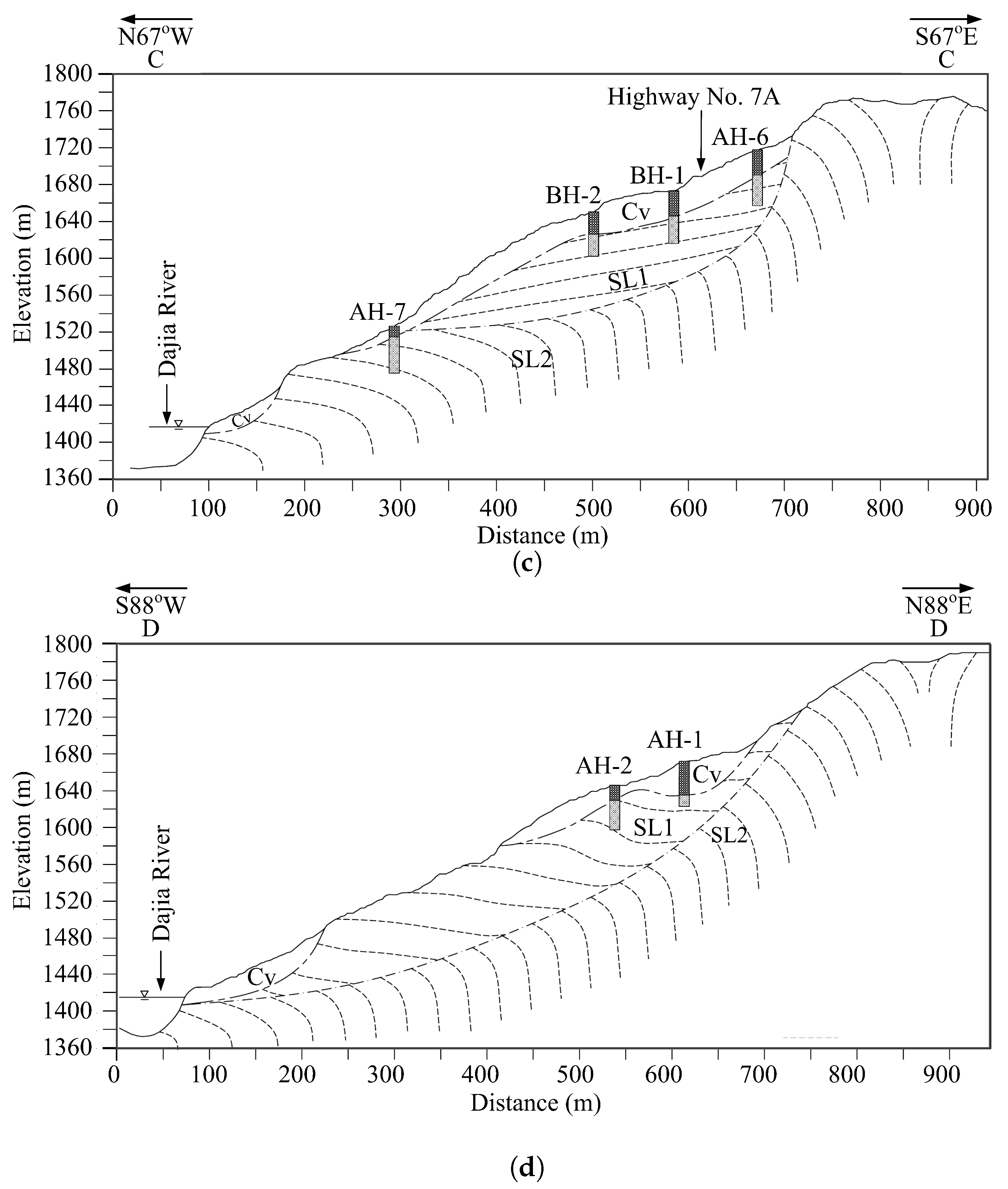
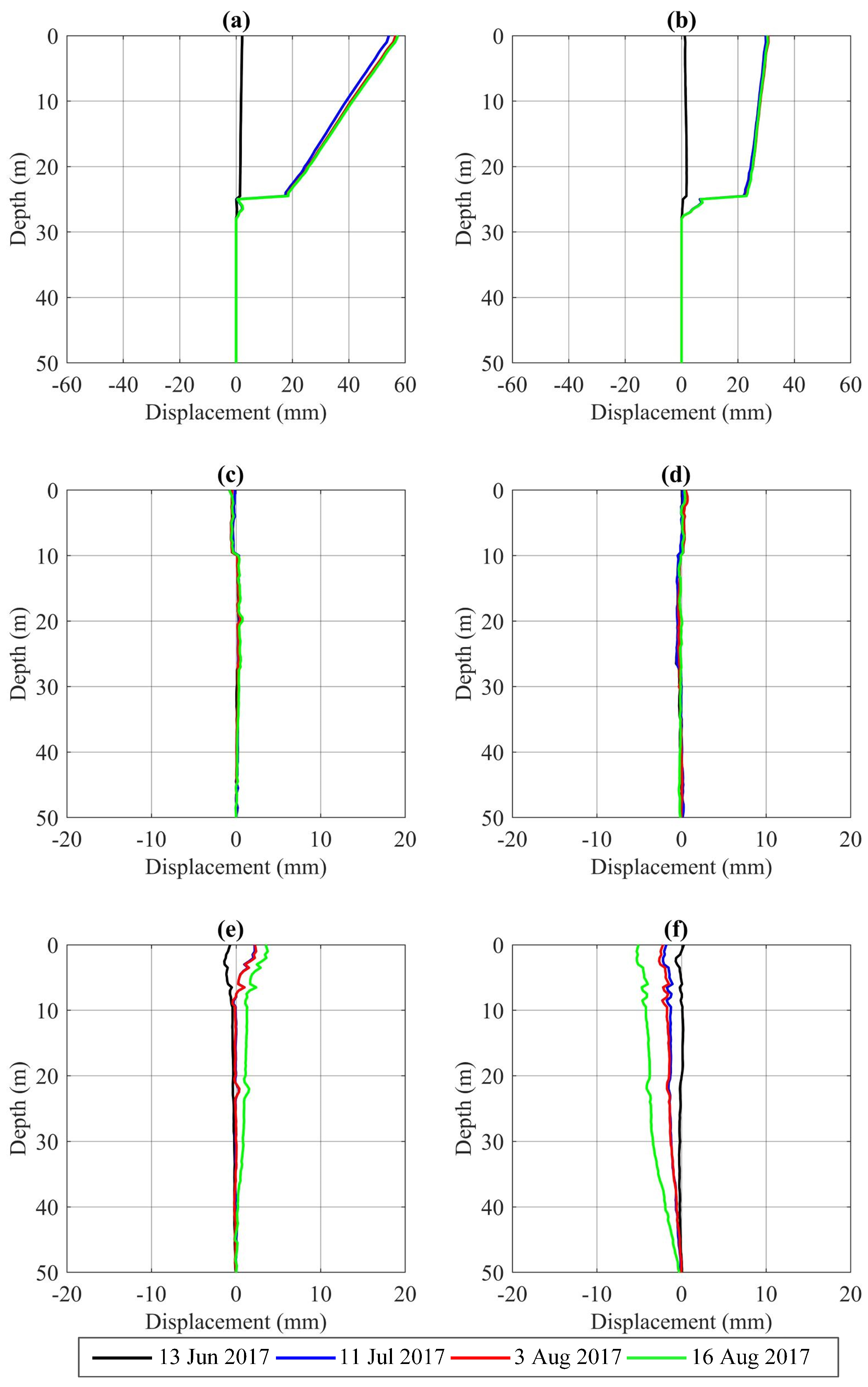
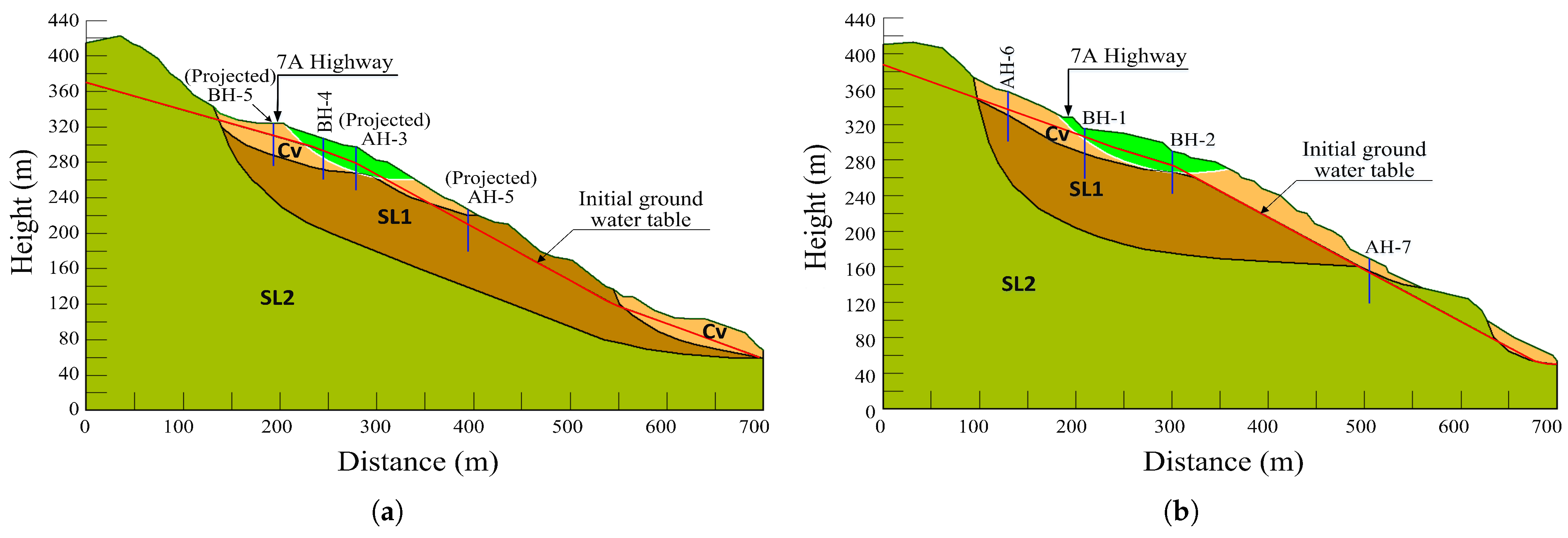
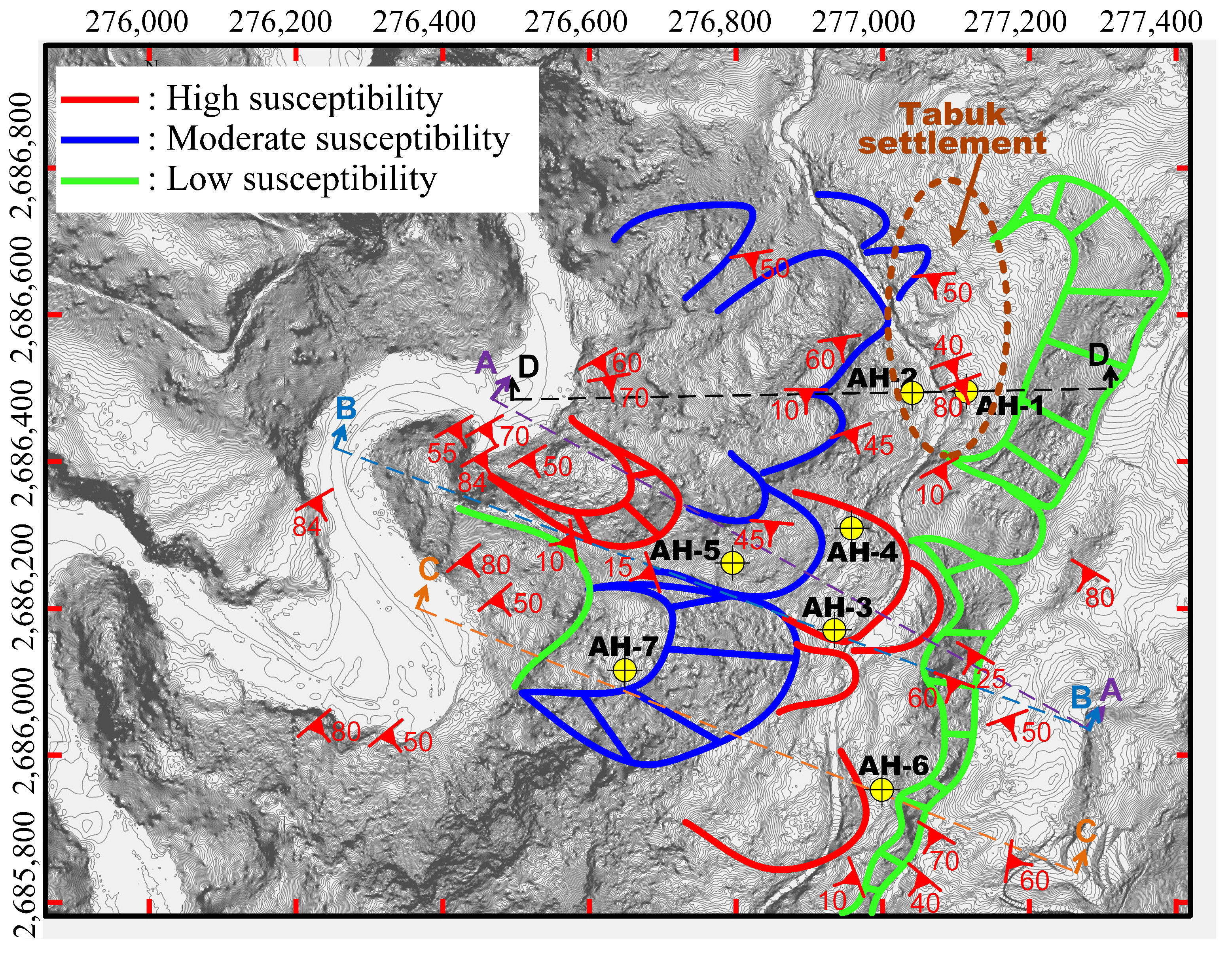
| Month | Jan | Feb | Mac | Apr | May | Jun | Jul | Aug | Sep | Oct | Nov | Dec | Yearly |
|---|---|---|---|---|---|---|---|---|---|---|---|---|---|
| Average (mm) | 90 | 180 | 213 | 249 | 284 | 330 | 199 | 254 | 204 | 88 | 60 | 60 | 2215 |
| Maximum (mm) | 504 | 710 | 786 | 938 | 560 | 920 | 691 | 784 | 1351 | 511 | 325 | 170 | 3771 |
| Year | 2016 | 1983 | 1983 | 1990 | 1984 | 2006 | 2004 | 1994 | 2008 | 2007 | 2012 | 2012 | 2005 |
| Landslide Locations | Nearest Rainfall Event | Date of Rainfall Recorded | Accumulated Rainfall (mm) | Date of Google Image Taken | Postulated Cause of Failure |
|---|---|---|---|---|---|
| 1, 2, 3 | Typhoon Toraji | 28 July 2001 | 244 | 1 February 2006 | |
| 4 | Typhoon Mindulle | 1 July 2004 | 645 | 1 February 2006 | rainfall |
| 5 | Typhoon Morakot | 6 August 2009 | 755 | 29 November 2013 | rainfall |
| 6 | Low pressure | 8 June 2012 | 674 | 29 November 2013 | rainfall and fluvial attack |
| 7, 8 | Typhoon Megi | 26 Sept 2016 | 327 | 30 April 2017 | rainfall |
| 9 | Typhoon Maria | 10 July 2018 | 276 | 30 September 2018 | rainfall |
| Material | Unit Weight | Apparent Cohesion | Friction Angle | Saturated Volumetric Water Content | Residual Volumetric Water Content | Saturated Hydraulic Conductivity | a | n |
|---|---|---|---|---|---|---|---|---|
| (kN/m3) | (kPa) | () | (m/m) | (m/m) | (m/s) | (kPa) | ||
| Colluvium | 22 | 0 | 23.5 | 0.30 | 0.02 | 4.6 × 10 | 2.00 | 1.35 |
| Slate (SL1) | 25 | 20 | 30.0 | 0.25 | 0.02 | 9.6 × 10 | 0.19 | 1.70 |
| Slate (SL2) | 25 | 20 | 30.0 | 0.21 | 0.02 | 3.8 × 10 | 0.19 | 1.70 |
| Observation Well No. | Highest Groundwater Level (m) |
|---|---|
| AH–2 | 5.5 |
| AH–3 | 14.0 |
| AH–4 | 19.0 |
| AH–5 | 13.5 |
| AH–7 | 15.5 |
Disclaimer/Publisher’s Note: The statements, opinions and data contained in all publications are solely those of the individual author(s) and contributor(s) and not of MDPI and/or the editor(s). MDPI and/or the editor(s) disclaim responsibility for any injury to people or property resulting from any ideas, methods, instructions or products referred to in the content. |
© 2023 by the authors. Licensee MDPI, Basel, Switzerland. This article is an open access article distributed under the terms and conditions of the Creative Commons Attribution (CC BY) license (https://creativecommons.org/licenses/by/4.0/).
Share and Cite
Gui, M.-W.; Chu, H.-A.; Ding, C.; Lee, C.-C.; Ho, S.-K. Hazard Mitigation of a Landslide-Prone Area through Monitoring, Modeling, and Susceptibility Mapping. Water 2023, 15, 1043. https://doi.org/10.3390/w15061043
Gui M-W, Chu H-A, Ding C, Lee C-C, Ho S-K. Hazard Mitigation of a Landslide-Prone Area through Monitoring, Modeling, and Susceptibility Mapping. Water. 2023; 15(6):1043. https://doi.org/10.3390/w15061043
Chicago/Turabian StyleGui, Meen-Wah, Hsin-An Chu, Chuan Ding, Cheng-Chao Lee, and Shu-Ken Ho. 2023. "Hazard Mitigation of a Landslide-Prone Area through Monitoring, Modeling, and Susceptibility Mapping" Water 15, no. 6: 1043. https://doi.org/10.3390/w15061043
APA StyleGui, M.-W., Chu, H.-A., Ding, C., Lee, C.-C., & Ho, S.-K. (2023). Hazard Mitigation of a Landslide-Prone Area through Monitoring, Modeling, and Susceptibility Mapping. Water, 15(6), 1043. https://doi.org/10.3390/w15061043








